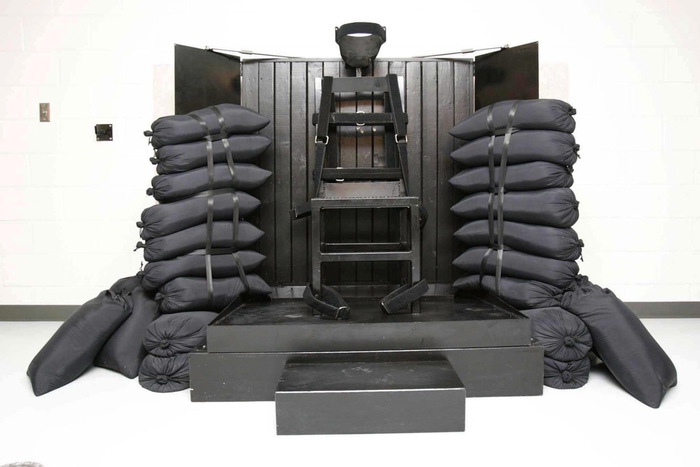I think this is the official photo of the firing squad execution chamber for the State of Utah. It was executed in 2010 for the killing of Ronnie Lee Gardner, who had requested death by firing squad. Though the firing squad was banned as a method of state execution in 2004, four other Utah death row inmates who had requested death by firing squad have been permitted to keep their choice. Today one house of the Utah legislature voted to reinstate the firing squad as a method of execution.
The structure consists of a chair made of welded steel square tube and a perforated seat; nylon and Velcro restraining straps for the executed person's feet, chest, and arms; and a height-adjustable steel neck and head brace, which has a piece of black impact foam where it hits the base of the skull, and a strap.
The chair is welded to a two-tiered pedestal; a steel plate box is bolted to a larger, painted wood box below. The top of the steel pedestal is not level, but is angled slightly toward the back. It is inset on the sides, and appears to have a small lip at the rear edge. A black painted wooden step is aligned with the chair, and is slightly shorter than the wooden pedestal.
A screen sits behind the executed's chair. Perhaps it is affixed to the wall. It comprises fourteen pieces of 2x4, painted black , and arranged vertically and set into an angle iron frame; and two half-width panels of steel, hinged, and kept open at an obtuse angle with locking brackets on top.
The spaces on either side between the platform and the rear screen panels are filled with sandbags. The sandbags are black nylon, cinched at the top with the tops all facing out. Nine sandbags are stacked vertically on each side and held in place with a single vertical nylon belt, and with horizontal nylon belts tight between every two sandbags. The 9th sandbag on top is lashed separately. At least three sandbags are propped diagonally against this stack to act as buttresses, bringing the total to 24.
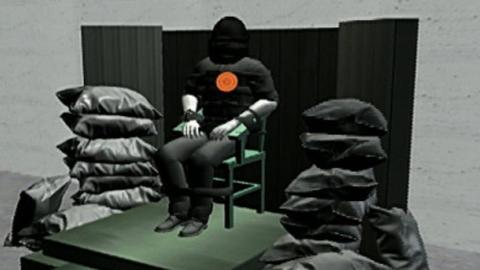
Five anonymous officers of the state are given rifles and told to aim for the executed's heart. From the digital rendering above, which appeared in the media the day before Gardner was killed, it would appear the person wears an actual target and is hooded before he is shot.
The photo up top was taken after Gardner was killed. There are bullet holes in the wood.
At this point in writing this, I looked for a closeup photo of the bullet holes--there were four--and found Salt Lake Tribune reporter Nate Carlisle's account of witnessing Gardner's execution. It turns out to be similar in style to this post; Carlisle's was experiential. Mine is material. Either way, detached observation and methodical recitation of facts seems to suit executions. Carlisle confirms the hood, and reports that Gardner's target was attached to his chest with Velcro.

Photographers and the Utah firing squad execution chamber in 1996, image: signaturebookslibrary.org
L. Kay Gillespie gave a similar eyewitness account in 1996 when Utah executed John Albert Taylor by firing squad. It appears Utah used the same chair as in 2010. The chair has a silver finish, not the darker, cold-rolled color of the panels. The bottom pedestal and step look to be the same, but the top pedestal is made of black painted wood. They look like theater props. The panels behind are only opened to an acute angle, however, and are constrained by chains, not elbow brackets. The rear panel looks to be covered with industrial-grade gray carpeting. Heavy black plastic sheeting is bunched behind the panels in a flat-topped, pyramidal shape. Perhaps it is stored covered. There are no sandbags visible.
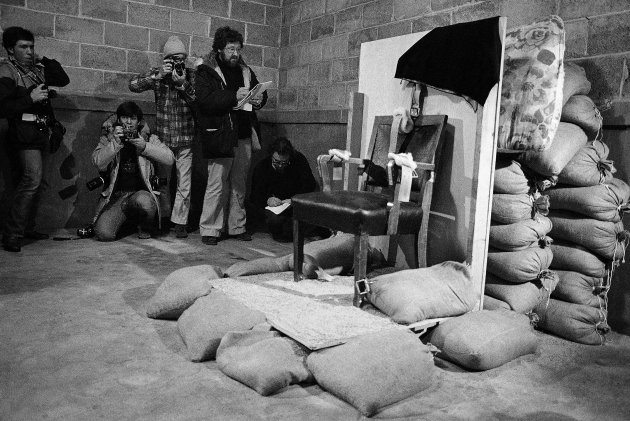
Photographers and the execution chamber where Gary Gilmore was shot in 1977. image: kuer.org
When the US Supreme Court lifted the ban on executions in 1967, the first person to be executed was Gary Gilmore, in 1977. He was executed in Utah, and insisted on being killed by firing squad. The execution chamber was an unpainted cinderblock room. The chair looked like it came from across the warden's desk. The structure under and behind it was made of plywood reinforced with two 2x4s on either vertical edge and burlap sandbags, plus a large, flowered cushion. And sheepskin covers on the restraining belts. This is how the government started executing people again. Looks totally legit.
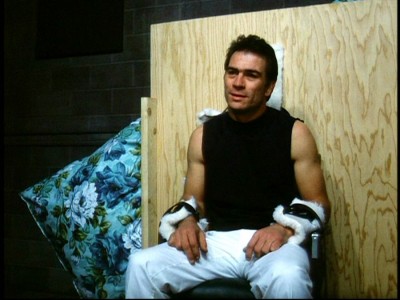
Gilmore was the subject of Norman Mailer's book, The Executioner's Song, which was commissioned by Lawrence Schiller, who directed the 1982 TV movie adaptation starring Tommy Lee Jones. Mailer appeared in another, stylized adaptation of The Executioner's Song in 1999: Cremaster 2 by Matthew Barney. Barney cast himself as Gilmore. Barney's execution takes place in a rodeo ring on the Bonneville Salt Flats. It is arguably one of the most unabashedly beautiful segments in the entire Cremaster Cycle.

I started this post because I saw the firing squad structure this evening, and it looked like a sculpture. It looks sculptural. At first, probably because of the references, I thought it looked like a Barney sculpture, but now it doesn't. Barney makes his things, but thIs is a readymade, albeit one at a fraught, probably dealbreaking extreme. I don't think you could exhibit it. At best you could replicate it.
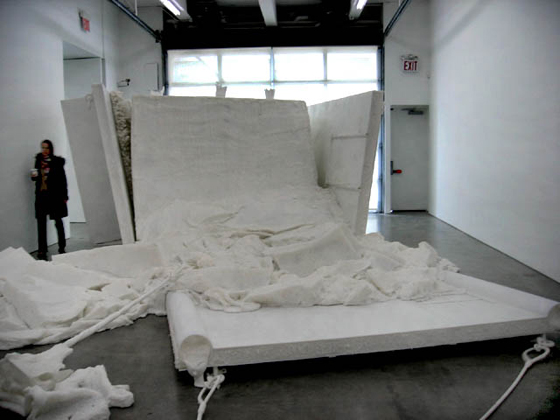
Matthew Barney, Deportment of the Host, 2006, Gladstone Gallery, via: old artnet
But such artistic appropriation is far less compelling than leaving it where it is, and studying the evolution of the execution structure and the aesthetic decisions that produced it. It is certainly possible to consider the Gilmore-era structure to have some found sculptural charm, but you cannot argue that anyone involved in building it gave the slightest damn about what it looked like. And the Taylor-era structure betrays a degree of institutionalized formality, with elements like the chair and pedestal that were designed and purpose-built. Form followed procedure. Color is meant to be absent, which means black, grey, and unfinished steel.
But the Gardner-era structure has been redesigned and rethought and rebuilt. The boards, the bags, the paint, the welded steel, more permanent than wood. It should be monochrome, symmetrical. Those sandbags and those straps really make the entire thing. Someone in Utah decided a firing squad execution structure should look like this, and so it does. That's more significant than any sculpture.
UPDATE: In the NYT, Michael Kimmelman weighs in, a little too gently, on the AIA's refusal to ban architects from desigining death chambers

